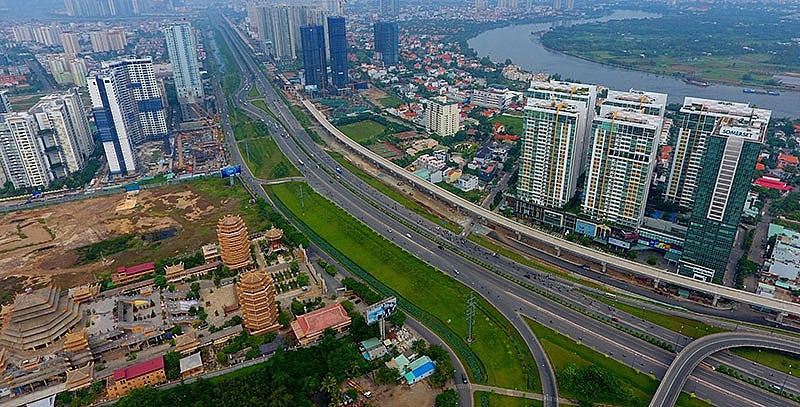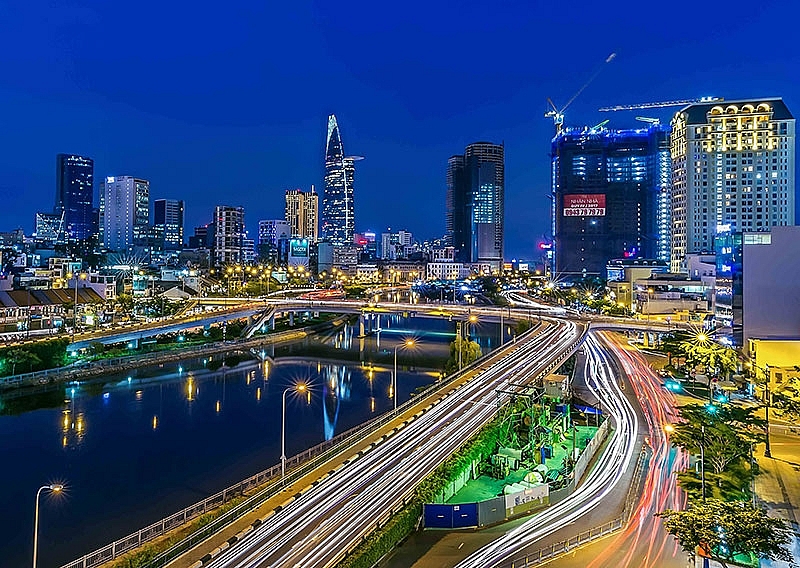Infrastructure bolsters realty market performance
 |
| Ho Chi Minh City is conducting multiple infrastructure projects to facilitate transportation and regional linkages |
Robust development
According to director of the Ho Chi Minh City Department of Transport Bui Xuan Cuong, since 2015 the city has built many important roads to ease traffic congestions and enhance regional linkages, as well as laid down the groundwork to relocate households this year.
Particularly, in 2015 Pham Van Dong Road was opened for traffic, linking Tan Son Nhat International Airport with the eastern and south-eastern parts of the city. Hanoi Highway was expanded, linking the east to the city centre. The city also completed the construction of two new streets—Nguyen Van Linh and Vo Van Kiet—connecting the city centre with the city west and south-western locations.
In addition, the city has expanded and upgraded Truong Trinh, Cong Hoa, and National Highway 22 heading to Long An and Tay Ninh provinces. Simultaneously, a raft of overpasses and underground tunnels were built and the construction of metro lines has started.
Surveys show that these new roads mainly consist of four lanes, helping to reduce traffic congestions. A significant point to note, after the roads were opened to traffic, associated real estate projects either reached the handover stage or began construction.
For instance, after Pham Van Dong Road completed construction and was put into use, a raft of high-rise and street-front villa projects were kicked-off by various developers, such as Dat Xanh, Him Lam Land, and Thu Duc House, along the road. The projects, namely 4S Riverside Garden, Opal Riverside, Opal Garden, 4S Riverside Linh Dong, and Tecco Tower, are crowding the road which spans across not only Ho Chi Minh City but also the southern province of Binh Duong.
Regarding Nguyen Van Linh Street, which connects districts 2, 7, 8 and Binh Chanh with Long An, before 2007—when the road did not exist—there were only a few projects selling land plots or street-front houses. High-rise projects were few and far between. After the 10 kilometre-long road was opened to traffic, real estate projects from diverse segments, from high- to low-end apartments and villas, sprung up on the roadside.
Similarly, after the 10km-long Vo Van Kiet Street connecting District 1 with Long An and some western locations was launched, a string of dying real estate projects resumed construction.
Even more, after Mai Chi Tho Road and Hanoi Highway were expanded, linking Ho Chi Minh City and the neighbouring province of Dong Nai, the regional real estate market has been revitalised.
According to figures from the Ho Chi Minh City Department of Transport, more than 50 projects consisting of over 30,000 housing units were in the development pipeline along the highways.
The on-going construction of the city’s Metro Line 1, albeit reporting slow progress, also provides a catalyst to the realty market. The project starts from Ben Thanh in District 1 and ends at Thu Duc District in Dong Nai. Since 2007, when the project kicked-off construction, at least 20 real estate projects with around 20,000 housing units were in the works along the metro line.
Commenting on the impacts of the transport infrastructure on the real estate market, Savills Vietnam managing director Neil MacGregor said that the city’s transport infrastructure and housing scene was facing huge pressure from the population. Therefore, the newly-built or expanded infrastructure projects in the past years helped significantly reduce traffic congestions in the city.
In MacGregor’s words, Ho Chi Minh City has gone the right way in urban development, that is, developing the city centre first, then the suburbs, and relocating people from the centre to the outskirts, following the example of developed countries.
“In European countries, satellite cities must be within a 200km radius, whereas Ho Chi Minh City and neighbouring provinces are only 30km distant, so these localities could be considered the city’s outskirts, helping to curtail transport infrastructure construction costs,” he said.
According to local developers, transport infrastructure is an important factor in project deployment. In hunting for land funds, developers’ major concerns revolve around what main roads will future projects face or whether there will be new infrastructure projects implemented soon in the area.
“The land plot fever in the real estate market in late 2016 and the first half of 2017 all stemmed from infrastructure-related information,” said Ngo Quang Phuc, deputy general director of Him Lam Land.
 |
| Growing traffic jams necessitate large-scale capital of infrastructure projects |
Infrastructure still in focus
On January 2, 2018, the Ho Chi Minh City People’s Committee hosted a conference on implementing the city’s socioeconomic development plans and budget estimates in 2018, one of the key contents of which related to transport infrastructure development.
According to Nguyen Thanh Phong, Chairman of the Ho Chi Minh City People’s Committee, last year the city completed and surpassed 16 out of 19 development targets, but the target of building transport infrastructure to alleviate traffic congestions fell below expectations.
This year, the city will scale up efforts to build a synchronised transport infrastructure system attached to urban embellishments to reduce traffic jams. Dozens of important transport projects will be implemented, such as the construction of ring roads 2, 3, and 4, connecting the city with Dong Nai, Binh Duong, and Long An.
In addition, overpasses will be built at crossroads, along with underground tunnels in different areas, such as An Suong Tunnel connecting Le Trong Tan Street with National Highway 22 and another tunnel at Hanoi Highway linking to National Highway 1A.
“In the long haul, it is necessary to source capital for expediting the projects on building ring roads 2, 3, and 4, which are essential to address traffic jams. Therefore, it is now a must to accelerate capital mobilisation for infrastructure projects,” Phong said.
According to Cuong from the Ho Chi Minh City Department of Transport, after nearly two years, the city has built 106km of new roads and 21 new bridges. Additionally, it treated 12 points that are particularly vulnerable to flooding during heavy rains.
“Several challenges need to be tackled this year, including the effective exploitation of existing infrastructure, doing a smart job with infrastructure development based on approved plans, and ensuring the efficiency of the existing public transport system. It is also important to apply science and technology to controlling transport works,” said Cuong, adding that the transport sector will focus on developing waterway transportation on the Saigon and Dong Nai rivers.
In Cuong’s words, this year, the city will focus on raising capital to accelerate the construction of Metro Line 1, along with expanding roads from the south to the city centre such as Hoang Dieu and Nguyen Tat Thanh in District 4, building Thu Thiem Bridge 2, expanding National Highway 13, and finishing the expansion of Hanoi Highway and National Highway 50. These projects will help the city alleviate traffic jams as well as contribute to relocating people to the city outskirts.
On the part of local developers, Phuc from Him Lam Land assumed that real estate developers should avail themselves of the opportunity by buying land plots for project execution in the outskirts.
What the stars mean:
★ Poor ★ ★ Promising ★★★ Good ★★★★ Very good ★★★★★ Exceptional
Themes: Vietnam Property Outlook 2017
Related Contents
Latest News
More News
- Green finance offers 'passport' for Vietnamese construction, building materials firms (December 15, 2025 | 08:00)
- Gamuda Land commit long-term investment (December 12, 2025 | 11:49)
- HITC ties up with Evolution to develop AI and hyperscale data centres in Vietnam (December 11, 2025 | 12:09)
- Real estate deals boom via high-profile names (December 08, 2025 | 11:32)
- Industrial segment shaped by M&As (December 08, 2025 | 08:00)
- The Privé sets the benchmark for luxury real estate (December 05, 2025 | 08:28)
- TD CASA and the rise of bespoke interior design in luxury living spaces (December 03, 2025 | 14:14)
- Lee Soo-man's Blooming Sky to build Gia Lai culture, sport, and entertainment complex (December 02, 2025 | 16:41)
- Sustainability in DNA of Keppel Vietnam's future urban development strategy (November 28, 2025 | 10:53)
- South Korean investors seek clarity on IP lease extensions (November 24, 2025 | 17:48)

 Tag:
Tag:





















 Mobile Version
Mobile Version